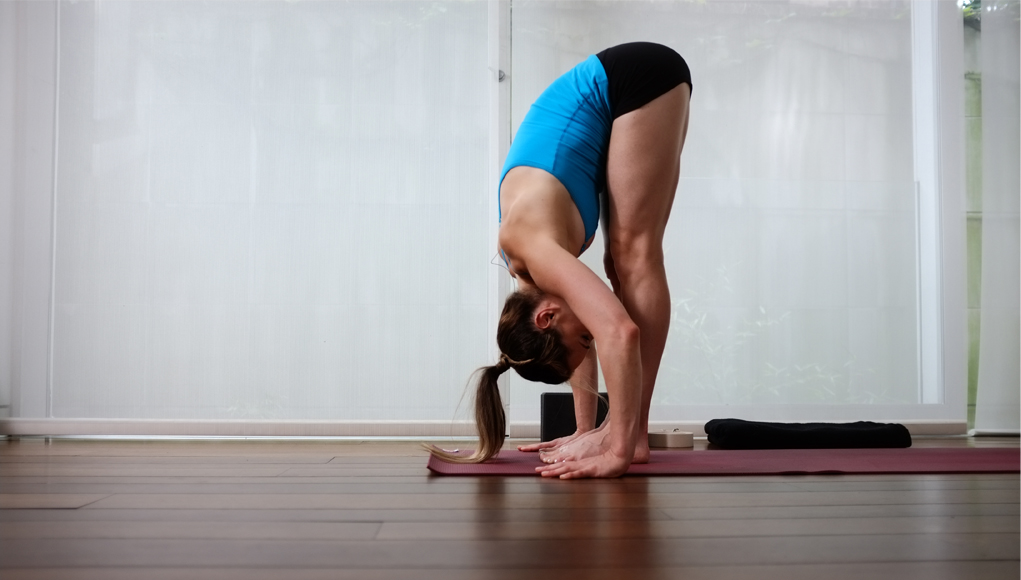Uttanasana is one of the most commonly performed of all the standing poses. It’s also one of the most useful, IF performed properly. In many classes it serves as a “rest period” between the poses of the standing sequence. It’s extension, ardha uttanasana, is also extremely important. Too often, we move into the standing forward bend from our belly, shorting and hardening the front torso. Ardha uttanasana reminds to continue to lengthen the front torso, and more importantly, the front spine.
UTTANĀSANA (oot-tun-AH-suh-nuh)
ut (actually ud) = a prefix suggesting power or powerful
tan = to stretch or extend (compare the Latin verb tendere, “to stretch or extend,” and English “tension”)
Intense Stretch Pose, commonly called Standing Forward Bend
1) Stand in Tadasana, hands on hips. Exhale and bend forward from the hip joints, not from the waist. As you descend draw the front torso out of the groins and open the space between the pubis and navel. As in all the forward bends the emphasis is on lengthening the front torso as you move more fully into the position.
2) If possible, with your knees relatively straight, press your palms or finger tips on the floor, either slightly in front of or beside your feet; if this isn’t possible, then cross your forearms and hold your elbows with the opposite-side hands. Feel the contact of the heels on the floor and lift the sit bones away from them toward the ceiling. Turn the top thighs slightly inward.
3) With each inhale in the pose, lift and lengthen the front torso just slightly; with each exhale release a little more fully into the forward bend. In this way the torso oscillates almost imperceptibly with the breath. Let your head hang from the root of the neck, which is deep in the upper back, between the shoulder blades.
4) Uttanasana can be used as a resting position between the standing poses. Stay in the pose for 30 seconds to 1 minute. It can also be practiced as a pose in itself for anywhere from 1 to 3 minutes.
5) Don’t roll the spine to come up. Instead bring your hands back onto your hips and reaffirm the length of the front torso. Then press your tail bone down and into the pelvis and come up on an inhale with a long front torso.
Benefits
Calms the brain
Stretches the hamstrings, calves, and hips
Strengthens the thighs and knees
Contraindications:
If you have a serious back injury, do this pose with bent knees, or perform Ardha Uttanasana (pronounced are-duh = half) with your hands pressed to a wall, legs perpendicular to and torso and arms parallel to the floor.
Beginner’s Tip:
If it isn’t possible to press your fingertips or hands to the floor with your knees relatively straight, use a pair of blocks to support them. Never struggle to touch the floor.
Intermediate’s Tip:
To increase the stretch:
1) Perform the pose with the balls of your feet supported on a low height (maybe 2 to 3 inches), heels on the floor. The higher the height, the deeper the stretch. Stay for a minute or more, come up with an inhale.
2) Stand facing an open wall, maybe 4 to 5 inches away. With an exhale, swing your torso to one side, bend forward, and touch your back to the wall. Now adjust: if the stretch is too intense, back away from the wall; if it could be greater, wiggle in closer to the wall. Stay for a minute or more, then press your hands to the floor and step back to Downward Facing Dog.
ARDHA UTTANASANA (are-duh oot-tun-AH-suh-nuh)
ardha = half
uttana = intense stretch
Half Intense Stretch Pose, commonly known as Half Standing Forward Bend Pose.
1) In Uttanasana, press your palms or fingertips against the floor (or against blocks on the floor) beside your feet. Straighten your elbows and, with an inhale, arch your front torso away from your thighs and lengthen between your pubic bone and navel as much as possible.
2) With your palms (or fingertips) push down and back against the floor (or blocks) as if trying to slide it (them) toward your heels; at the same time, lift the top of your sternum up (away from the floor) and forward (toward the opposite side of the room). You might bend your knees slightly to help get this movement, which will concave your back and convex your front torso.
3) Look forward, but as usual be careful not to compress the back of your neck. Hold the concave back position for a few breaths, then with an exhale release your torso into full Uttanasana.
Contraindications:
With any neck injury, don’t lift the head to look forward; otherwise same as those of Uttanasana
Benefits: (in addition to those of Uttanasana)
Stretches the front torso
Strengthens the back and improves posture
Stimulates the belly
Beginner’s Tip:
When lifting and lengthening the front torso, if the backs of you legs are tight, bend your knees quite a bit to avoid stressing the lower back.
Intermediate’s Tip:
To intensify the stretch on the back thighs, bend your knees slightly and cross your forearms behind your calves. Firm the arms against the calves and lift and lengthen the front torso as described above. Hold that length, continue to resist the calves with the arms, and push back firmly against the top thighs. Let the front torso be drawn into a deep fold, maintaining as much of the length along the front torso as possible.

